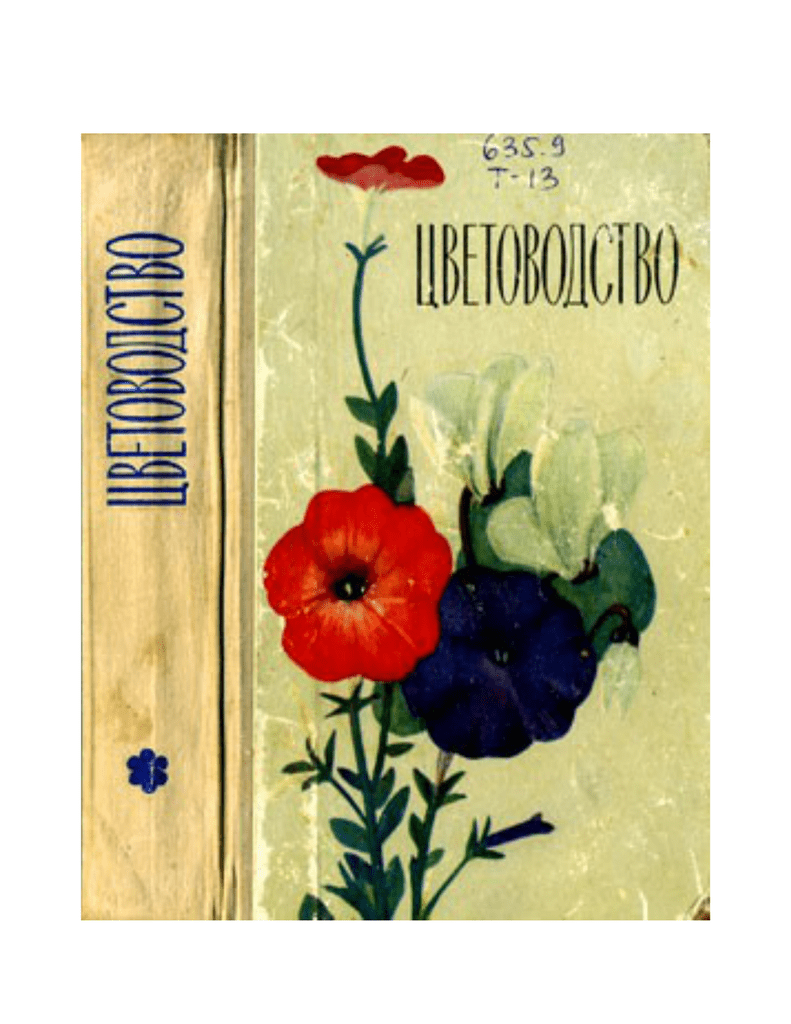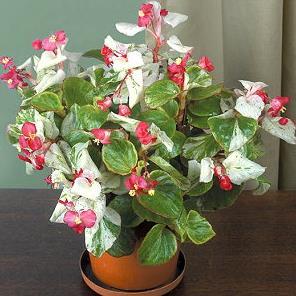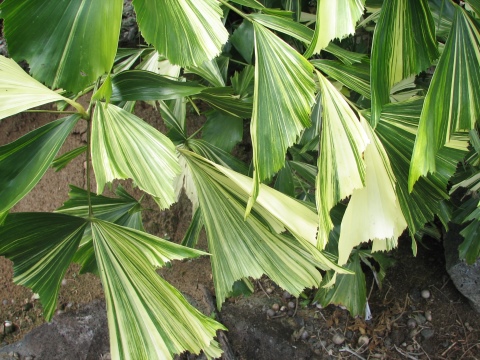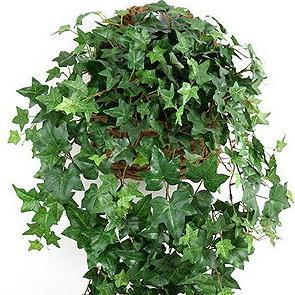Hoya and liana bush varieties

Hoya bella var. Louis Buis is a beautiful hoya bush variety with leaves that have golden spots in the center and a reddish central vein in good lighting conditions.
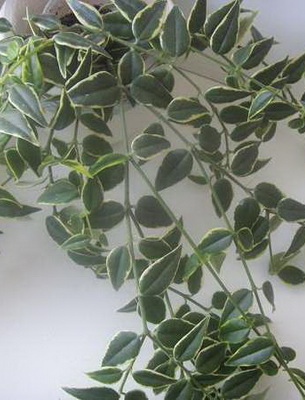
Hoya bella Variegata is a plant with foliage with a thin edging of a white or yellowish tint.

Hoya bella Wee is a wonderful hoya variety with especially small leaves, which are placed in a whorl not in two, as usual, but in three.
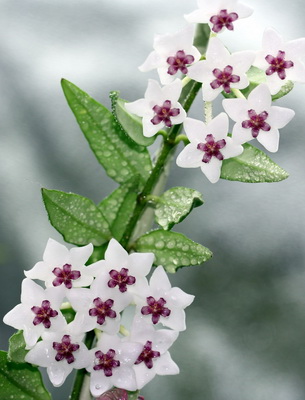
Hoya fleshy got its distribution due to picky to growing conditions and ease of care. Unlike the previous species, this is not a bush plant, but an evergreen climbing vine.
Its length can be 6 m, so when growing a crop, you should take care of the support. The foliage of the plant is oval, thick, hard, dark green, has a shiny surface, reaches about 8 cm in length. The inflorescences are umbrellas, which contain 20 flowers each with a strong pleasant aroma. The main color of the petals is white, in the central part there is a pink crown.
Evaluate in the photo what varieties and varieties the fleshy hoya has:

The images show the most popular in home gardening.

Hoya carnosa Variegata (hoya variegated), in particular its variety called "Krimzon Queen", which is famous for its unusually delicate cream-colored edging around the edges of rich green leaves.

Hoya carnosa Tricolor (hoya tricolor) and its variety with the original name "Exotic", which is loved by many professional and amateur gardeners thanks to its scarlet flowers and green-pink-cream foliage.

A hoya flower such as a majestic one is also a climbing vine. It is densely covered with lanceolate-oval foliage, the length of which reaches 15 cm, and the width is up to 8 cm.The color of this plant is considered the largest among the known species: the diameter of the flowers is 8 cm.The flower stalks are long, flower umbrellas are formed on them, in each of which contain from 8 to 10 smooth star-shaped flowers with rich red petals and a white central crown.

On the reverse side, the petals are decorated with an admixture of green or yellow. Hoya imperialis is widely known for its pleasant perfumery scent.
A description of the popular varieties of this type of hoya with photos and official names for your attention is presented below - study and choose the green "pet" that is most suitable for your greenhouse:

Hoya imperialis var. rauschii is distinguished by foliage with wavy edges, white-green flowers with pink and purple hues.

Hoya imperialis "Borneo Red" is popular due to the fact that it grows very quickly, blooms in lilac color with a fruity sweet smell.

Hoya imperialis var. Palawan is famous for its yellow-golden flowers, which have an original slightly reddish tint.
The photo below shows the long-leaved hoya:

This is a climbing plant, the thin shoots of which contain a large amount of milky juice. Liana is densely covered with lanceolate foliage, smooth edges, rich green color, fleshy structure without visible veins. Each leaf is approximately 13 cm long and approximately 2 cm wide.

What a long-leaved hoya looks like, check out the colorful photos.

The concave hoya is an epiphytic plant, very branched, with flexible branches that look like growing very densely cascading lashes. The foliage is diamond-shaped, thickened, with edges curled inward, of a rich green color. The length of each leaf does not exceed 6 cm. The inflorescence is an umbrella shaped like a fluffy ball. One umbrella contains 15 to 20 fleecy white or cream flowers with a white crown topped with a yellow center.
Description of popular varieties concave hoya with a photo, explore below:

"Tova" is a hybrid with a monochromatic foliage, which has a light green color.

"Eskimo" is a cultivar with leaves decorated with a marble pattern of a lighter shade.
Asparagus species
Asparagus racemosus / Asparagus racemosus
The shoots of this species reach 2 m in length. Cladodia (modified shoot) grow in heaps of several pieces. The flowers gather in racemose inflorescences and smell quite nice.
Asparagus medeoloides / Asparagus medeoloides
The stems of the plant are straight, and the plant itself grows in nature to a fairly large size. The stems branch profusely.
Asparagus meyeri / Asparagus meyeri
Shrubs represent the species. The shoots of this species, unlike many others, are pubescent, grow in length to a little more than 0.5 m. The needles on the shoots are densely located. This type is used both for compositions of fresh flowers and in cut bouquets.
Common Asparagus / Asparagus officinalis
Also called the plant asparagus and medicinal asparagus. Representatives of the genus are herbaceous perennials. Stems are straight, not pubescent, smooth, grow up to 1.5 m in length. The branches are straight, growing vertically or at a slight angle. Cladodia (modified shoots) grow at an angle, directed upward or along the trunk, filamentous, up to 3 cm long, narrow. The leaves, like other species, are scaly. Both male and female flowers can grow on the plant, female flowers reach 2.5 cm in length, and male flowers are twice as large, the flowers are white-yellow. Fruits are red, rounded berry.
Asparagus plumose / Asparagus plumosus
Also known as Asparagus setaceus. It lives in tropical and subtropical zones in the south and east of the African continent. Representatives of the genus are semi-shrubs with non-pubescent and branching shoots. The leaves are very small triangular scales. Phylloclades (modified stems) grow in several pieces, light green, curved, reaching 1.5 cm in length and up to 0.5 mm in width. Flowers are white, grow in 2-4 pieces or one at a time, small in size. Fruits are black and blue, contain up to 3 seeds. It does not bloom indoors, but it is easy to take care of the species. Most often in the culture there is a pinnate dwarf asparagus.
Asparagus crescent / Asparagus falcatus
This species is distinguished by the longest shoots (up to 15 m), which are also the thickest (up to 1 cm), but this is in the wild. Even in a greenhouse, this vine is unlikely to reach more than 4 m in length. Cladodia in this species have a crescent shape, grow on shoots extending from the rhizome of the plant, reach 8 cm in length, the edge of the cladiod is corrugated. Flowers are collected in sparse inflorescences, have a pleasant aroma, white.
Asparagus asparagus / Asparagus asparagoides
This species is also called asparagus asparagus. Distributed in South Africa. Grown as an ampelous plant or on a support. Stems are light green, not pubescent. Shoots are thin, ovoid, glossy, the same color as the stems, leaf-shaped. Indoors usually does not bloom, flowers are small and white. The smell of the fruit is very similar to the smell of an orange, the color is red-orange.
Asparagus finest / Asparagus benuissimus
This species is not much different in appearance from asparagus pinnate. The main differences are longer shoots (up to 1.5 m), and phylloclades are narrower and longer, and do not grow as densely as those of a relative.
Sprenger's Asparagus / Asparagus sprengeri
It is also known under other names: dense-flowered asparagus (Asparagus densiflorus) or Ethiopian asparagus (Asparagus aethiopicus). Indoors, it is grown as a herbaceous perennial. The stems of the plant are weak, but long - up to 1.5 m long, not pubescent, can be smooth or with small grooves. Leaves - 2-4 cm scales. Phyloclades grow in one or 2-4 pieces, can bend or grow straight, reach 3 cm in length. Flowers have a pleasant aroma, they are pink or white. The berries are red, 1 berry yields 1 seed.
Poisonous indoor plants
After this article, they usually read
Add a comment
Hoya: appearance and other characteristic features
Hoya, also known by the nickname "wax ivy", is a genus of evergreen lianas belonging to the Apocynaceae family. Most of the nearly three hundred of its representatives can be found in Southeast Asia, India, China, on the islands dividing the Indian and Pacific Oceans. Some hoyis look like compact bushes, but this configuration is relatively rare.
In nature, hoya is an epiphytic plant. She lives in forests and undergrowth, using tall trees as a support for her lashes. She does not need anything else from the "owner", she is not a parasite. If no suitable tree is found, the vine winds along the ground. On average, it reaches 10 m in length.
Hoya in nature is an epiphyte that uses tree trunks as a support
Hoya flowers, collected in dense corymbose or spherical inflorescences, look very unusual. They have the shape of regular five-pointed stars with a diameter of 1–2 cm, inside which there is a "crown" - a star of less contrasting shade. The surface of the petals is fleecy, they seem to be carved from velvet. The color gamut is very wide - from cream to dark purple, which appears black from a distance, including various tones of yellow, pink, red, peach and silvery green.
Hoya flower in the shape of a regular five-pointed star may seem artificial
More than twenty inflorescences can form on an adult liana at the same time. They emit a rich, pleasant aroma, especially intensified at night. The "sweet" smell evokes associations with marshmallows and caramel. Not everyone likes it, sometimes even causing a persistent migraine. Small droplets of a thick translucent substance on the petals are nectar, and not some kind of exotic disease. Each flower lasts 15–20 days.
Inflorescences in the form of an almost regular ball immediately attract attention
Many growers are afraid to start hoya at home, knowing about the signs and superstitions associated with ivy. Allegedly, the plant "survives" from the house of men dear to the mistress. Even if you believe in this, the hoya has absolutely nothing to do with ivy, which is part of the Araliev family.
Hoya will organically fit into any interior, here you are limited only by your own imagination
The flowering period stretches from May to October, but the rest of the time the hoya also looks pretty. Young shoots have a chocolate-purple hue; as they grow older, they become brown-gray and lignified. Leaves are fleshy, hard to the touch, in the form of an ellipse with a pointed tip, located opposite. Young ones have a characteristic glossy shine, adults - matte. The length of the leaf is 6–8 cm, the width is 3–5 cm. It is for their texture that the plant has received the nickname “wax ivy”.
Hoya leaves are also very decorative, but still this is not the main advantage of the plant.
Varieties of tropical plants
Currently, there are over 200 species of graceful perennials. This species diversity turns asparagus, a mix from which it will be very easy to create, into an indispensable plant for floristry. For cultivation at home, the following varieties are considered most suitable.
Asparagus pinnate or asparagus bristle (Asparagus plumosus)
Strongly branching dwarf shrub, native to the tropical forests of Africa, with soft central shoots that have a slight bend, which gives the appearance a special decorative effect. The stems are covered with scaly leaves 0.5 cm long, in the axils of which groups of threadlike branches up to 1.5 cm develop.

Due to lateral shoots located in a horizontal plane, a separate branch has a peculiar similarity to a fern leaf. During flowering, which is practically not observed in an apartment environment, single white flowers bloom.
Asparagus the finest (Asparagus benuissimus)
The species is very similar to the previous one, differing only in the structural features of the cladodia: they are thinner, elongated and located much less frequently.

Asparagus sprengeri (Asparagus sprengeri), aka dense-flowered asparagus
An evergreen creeping perennial that lives in the wild on the slopes of the mountains of the South African region. Bare stems, reaching a length of 1.5 m, are covered with scaly leaves up to 4 mm, surrounding groups of 3-4 slightly curved cladodia 3 cm long.

Flowering is noted when pink or white fragrant flowers bloom, collected in shield inflorescences. The species has characteristic rounded red fruits. In the literature, it is often found under the name Ethiopian asparagus.
Asparagus meyeri
A species with single shoots half a meter high, which are very densely covered with phylloclades, developing in different directions. The appearance of an individual shoot resembles a fluffy brush.

Sickle asparagus (Asparagus falcatus)
Liana-like representative of the culture with lignified, spiny stems, reaching in the natural environment 15 m in length with a diameter of 1 cm. The formations in the form of thorns allow it to climb the support without any problems. Easy to care for at home, this asparagus has shoots with a maximum length of 4 m.
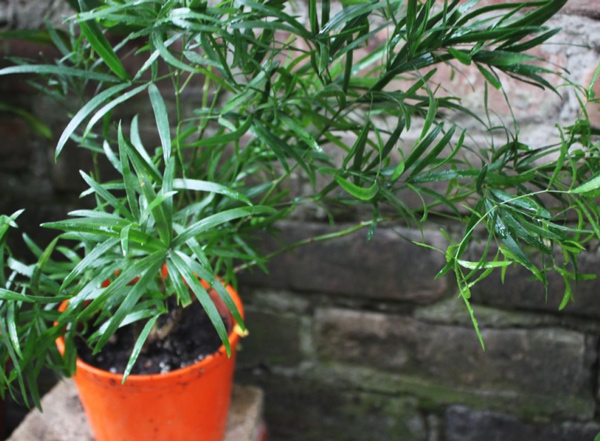
In the upper part of the lateral shoots, covered with scaly undeveloped leaves, dark green sickle-shaped cladodia up to 10 cm in length develop. The perennial has good pruning tolerance. When flowering, forms racemose inflorescences, consisting of small cream-colored flowers.
Asparagus racemosus (Asparagus racemosus)
A semi-shrub with climbing shoots, the length of which reaches 2 m. The name is due to inflorescences in the form of a brush, consisting of bright pink flowers with a characteristic aroma.

Asparagus medeoloides
Liana stands out for its tallness and very strong branching with evergreen cladodia. The peculiarity of the shoots after cutting for a long time to keep freshness without water determined its popularity among florists.

Asparagus pyramidal (Asparagus pyramidalis)
A semi-shrub with erect shoots up to 1.5 m in height. The shoots are densely covered with short cladodes, which from a distance the plant can be mistaken for a juniper.

Asparagus asparagus (Asparagus asparagoides)
A beautiful climbing perennial with stems 3 m long, which are covered with bunches of cladodes up to 3 cm.

In addition to cultivation in an apartment environment, the following types are suitable for growing in open ground for regions with a temperate continental climate:

Green asparagus, or edible asparagus, is a highly branched plant, rich in trace elements and vitamins, with a powerful rhizome and underdeveloped leaves. Asparagus sprouts are eaten fresh and for the preparation of various dishes.

Uses of asparagus
Asparagus is used in various areas of life:

- Cooking. Three types of asparagus (white, green, and purple) are used for food and are rich in micronutrients and vitamins. The most common and readily available is green asparagus, without which some culinary recipes cannot be implemented.
- Ethnoscience. The beneficial properties of this flower are not limited to purifying the air and enriching it with phytoncides. The perennial has medicinal qualities that can fight gout, liver diseases and other ailments, having sedative, analgesic, vasodilating, diuretic, and blood-purifying effects.
Advice! Do not forget that no matter how undeniable the benefits are, and the harm from using the plant also exists. In some cases, asparagus can act as an allergen.
Thus, due to the unpretentiousness of the perennial and its high decorativeness, asparagus is popular among lovers of tropical flora.

Spectacular ampelous plants such as Robot asparagus or Abu Dhabi asparagus with graceful flowing stems will add coziness to any room, adding bright colors of greenery to the interior.
Watering and feeding when caring for a hoe (with video)
An important aspect of caring for a home flower hoya is watering: moderate in summer, even less in winter. A feature of the culture is the ability to tolerate moisture deficit well. In the warm season, it is necessary to water the plant as the soil dries out, but it is still better not to let the earthy one dry out.In order for a vine or bush to please with abundant flowering in the next season, a minimum amount of liquid will be required during winter dormancy. If the soil is waterlogged, the plant can begin to shed both leaves and shoots. Water for irrigation should be used settled, soft.
The ready-made mixture "For flowering succulents" can be purchased at a flower shop, or you can make it yourself at home, taking into account the recommended ratio of components:
- 2% magnesium.
- 10% nitrogen.
- 11% phosphorus.
- 18% potassium.
The solution must be poured into the pot along the edge. During winter dormancy, the plant does not need to be fertilized. Also, feeding is not required at all if you carry out an annual culture transplant into a new, not yet depleted substrate.
For information on how to organize proper care for the hoya, see the video presented to your attention below:
Hoya home care
Indoor hoya is a tropical, equatorial plant that loves bright diffused light, but direct sunlight should be shaded. Hoya is a gorgeous beauty with a special love for year-round warmth. In summer, it feels great at a temperature of 25 degrees, it also tolerates an elevated temperature of 30-35 degrees, and in winter it is not lower than 16 degrees. And it is necessary to water the indoor wax ivy regularly and abundantly in summer and limited in winter. Hoya especially needs a reliable support to keep it upright. And then the hoya plant will not only decorate an apartment, office and any ampelous composition.
Hoya breeding
Hoya can be propagated by layers, seeds, and most simply by cuttings. The optimal number of pairs of leaves is two, and it is necessary to cut off the stalk between the nodules. Rooting of cuttings takes place within a month in water or in a sand-peat mixture.
If such a treasure as hoya seeds has appeared, they need to be dried and sown in loose soil, the seedlings that have sprouted in a week must be watered regularly and provided with warmth and a bright place.
It is easy to propagate by layering. You need to make an incision on an adult plant, wrap it up with moss and a plastic bag. When roots appear, cut off this shoot and transplant it into a pot. Already in the year of planting, the plant will definitely bloom. Hoya flowers always appear in the same place - on special formed processes. It is undesirable to pick off flowers on the plant, because new ones will grow in the same place.
Hoya transplant
Hoya is transplanted no more than once every three years. To achieve good rapid growth, plants need to be planted in a looser pot, and to stimulate abundant flowering, the pot must be cramped. When transplanting, it is advisable to steam the soil for neutralization in order to prevent root nematodes. Drainage is required and there are holes in the bottom of the pot.
Hoya diseases and pests
Hoya growing it at home is not particularly difficult. This plant is resistant to pests and diseases. But you can't let everything go by chance. After all, poor hoya care can lead to the appearance of a scale insect or a red spider mite. The reproduction of pests must be urgently prevented by treating the plant with chemicals.
It must be remembered that it is not advisable for people with allergies to have a hoya at home. After all, all parts of the plant are poisonous
Care must be taken in the content. And then the blossoming hoya flowers will delight and enchant for a long time with their extraordinary beauty and wondrous aroma.
Home care
Creating an optimal microclimate and maintaining it all year round are seemingly familiar requirements for plant breeders. However, home care for the hoya has important nuances.
Temperature
It is recommended to keep the flower at a temperature of 18 ... 25 ° C. In winter, the appearance of the plant remains the same with a thermometer reading above 15 ° C. A lower temperature provokes leaf fall, followed by a difficult recovery period.
Important! Hoya beautiful does not tolerate temperatures below 18 ° C.
Location, lighting
For creepers from the tropics, favorable lighting conditions are near the east or west window of the apartment. In winter, when the intensity of sunlight decreases, the pot can be moved to the south side.
Daylight hours for vines should last at least 10 hours at any time of the year. Backlighting in winter is especially needed for species with variegated leaves. Varieties with a monochromatic dark color will tolerate a short partial shade.
Advice! You can not rearrange (even turn) the vine during the budding period. Whenever the location is changed, the hoya resets the entire typed color.
Flowering features
All types of hoya differ in shade and shape of flowers. Each bud retains its attractiveness for almost 3 weeks, and a new one appears in the place of the dropped one. Due to this feature, the flowering period is often extended throughout the summer. Most varieties, at peak flowering, exude a unique aroma that can be felt in a few steps.
Watering
Watering varies depending on the type of vine. Most varieties with fleshy leaves are watered after the substrate dries up to 3 cm. If the leaves are thin or with a pile, then they always need slightly moistened soil.

Bathing
Bathing is an unusual way to stimulate hoya blooms:
- The pot is lowered into a basin of warm water (up to 40 ° C) for 3 hours.
- If the plant is immersed together with the leaves, then the duration of the procedure is reduced to half an hour.
- After that, the liana with earth is dried in warmth with diffused lighting.
The manipulation is recommended to be carried out in early spring and autumn before the dormant period.
Air humidity
Experienced growers find that regular spraying improves flowering and accelerates growth.
During flowering, be careful not to let the water get on the petals. It is better to replace for this spraying period by wiping the leaves
This procedure should be carried out to remove dust 2-3 times a month.
Transplant and pot
Despite the rapid growth rates, the liana does not have to change the pot every year. On the contrary: in a small cramped area, the hoya blooms more abundantly.
It is recommended to renew the substrate and flowerpot every 2-3 years.
Advice! If you want to grow a hoya with a massive crown, the pot is selected a little more, and the plant is transplanted annually. Then the liana will not bloom and will direct all its forces to the growth of greenery.
The pot must be new. How much to increase its diameter - 5 or 3 cm - depends on the desire to get greens or flowers.

The transplant itself is carried out in the following sequence:
- Fill the bottom of the new pot by 4 cm with drainage.
- Fill the top with prepared soil up to a quarter of the height of the flowerpot.
- Install a support if necessary. It is advisable to use metal arcs or gratings that can withstand the weight of the green mass.
- Remove the plant from the pot, previously watered for half an hour, without damaging the earthen lump with roots.
- Transplant into a new flowerpot and cover the free space with earth.
- Water a little and, if necessary, top up the substrate on top.
Caring for a transplanted hoya is simple: reduce watering, protect the leaves from sunlight and dry air.
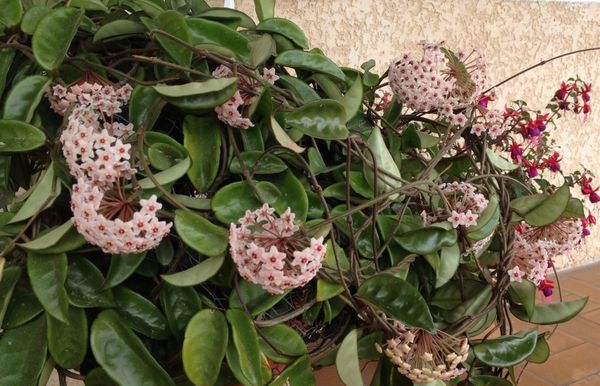
Soil and fertilizers
The approximate composition of the soil may be as follows:
- peat, leafy soil, river sand and humus in equal parts;
- universal soil, humus and loam in a ratio of 1: 1: 2;
- substrate for orchids and universal soil for flowering plants in equal volumes.
Important! The acidity of the finished composition should be neutral or slightly acidic.
Hoya needs top dressing regularly during the period of active growth (spring - mid-autumn). Among the ready-made solutions, the choice can be stopped on fertilizer for succulents or flowering indoor plants. To replenish the composition of nutrients, it is enough to water twice a month with top dressing.
Pruning
Hoya (photo) will look attractive over the years if, in addition to leaving, the vine is regularly cut off - best in the fall, when the flowering has stopped.

The branches hanging from the pots are cut in half. It also stimulates abundant flowering in the next season.
Important! After the buds fall, the peduncles are not cut off. Hoya forms new inflorescences on them next year.
Climbing indoor plants - photo
Climbing plants for the home are an excellent material for creating not only single phyto-compositions, but also luxurious vertical phyto-walls, the design of which has recently become quite popular. It is worth noting that both ampelous plants with cascading stems and various climbing and intertwining vines can take part in the compilation of multi-tiered compositions, especially since they all, as a rule, have the same microclimate requirements. You can find out more about the varieties of climbing indoor plants, as well as their place in interior phyto-design, in our gallery. Happy viewing!















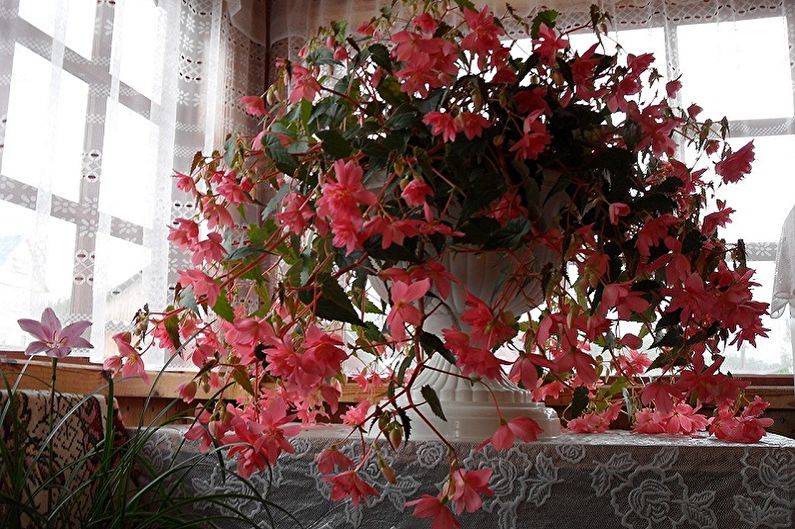
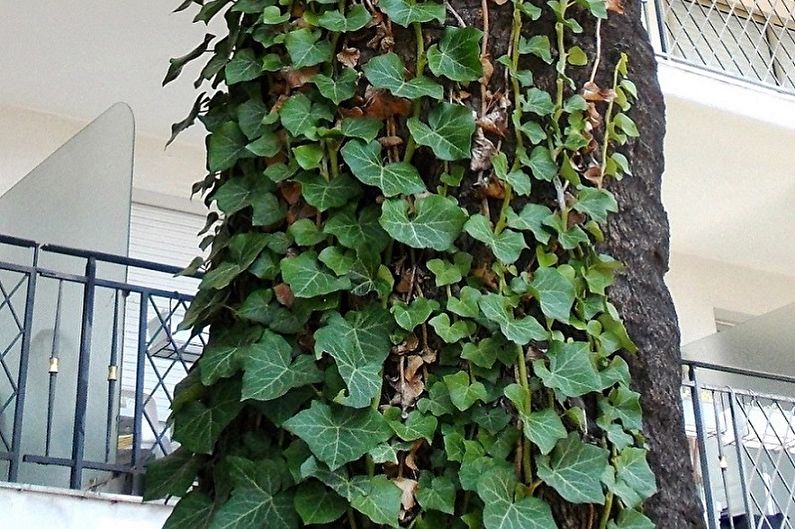






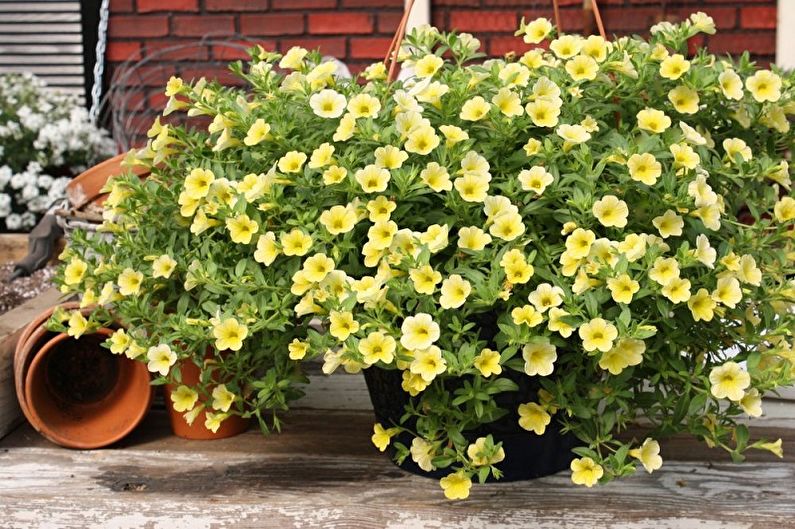



Planting homemade hoya cuttings and caring for the plant
Planting hoya with apical or stem cuttings is carried out as follows: the cutting is placed in a plastic bag filled with a slightly moistened substrate so that the lower node is covered with soil. Then the bag is placed horizontally, and after 10 days, the emergence of roots can be observed in it.
After 14-21 days, you can get a germinated stalk, ready for planting in a permanent place of growth in the soil, prepared according to one of the previously described technologies.
Rooting in water is carried out as follows. The container with the liquid is wrapped in foil on all sides, and holes for the cuttings are made from above in the wrapper. Planting materials processed at the request of "Kornevin" are lowered into a bowl so that the lower node is under water. A plastic bag is also put on the container loosely (for free air flow). Roots will appear after 14 days. It is necessary to transplant the cutting into the ground immediately, since the roots will become very fragile and can break off.
Varieties
More information about the varieties and types of indoor ivy can be found here. As for the garden, the support for ivy can be arches, gazebos, trees, fences, the wall of the house. It is this ability to adhere tenaciously to almost any object that unites the numerous varieties of this street plant.

In Russia, more often preference is given to four types of evergreen vines, more frost-resistant than their counterparts.
Common garden ivy
Hedera helix or common ivy is a common species.
-
- The creeper has shiny dark green leaves, which are decorated with white veins. Suction-shaped roots help the climbing shrub cling to trees and other supports.
- The liana can be up to 30 meters long, it is good to use it in vertical gardening. Common garden ivy is also used as a ground cover plant.

- The plant belongs to melliferous plants, white honey with a mint aroma is obtained from the flowers. But a person can be poisoned with berries, unlike birds. They are especially fond of pigeons and blackbirds.
- Shrubs like places where partial shade reigns and there is no wind. This species is considered the most winter hardy.
- Differs in a large varietal variety. Each variety has its own zest - Eva and Mona Lisa are yellow in color, Sagittaefolia has star-shaped leaves.
Colchis ivy
Hedera colchica is Colchis ivy, also called Caucasian ivy. There it is found in its natural habitat. This liana is powerful, strong, capable of lifting up to 30 meters in height on the support.

The plant is decorated with large leaves, which can reach a length of 20-25 centimeters, and a width of 17 to 20. The leaf plates are often solid, the three-lobed form is less common. The color of the leaves is mostly green, but there are also spotted varieties.
In terms of growth rate, Colchis ivy is ahead of ordinary ivy, but it is more afraid of frost. Liana loves partial shade and fertile soil.
Purple, treelike and jagged plant forms are more common.
Ivy boston
This is also a liana - tree-like, lush and dense. It can reach a height of 20 or even 30 meters.

REFERENCE: This plant, unlike common ivy, Colchis and Crimean ivy, does not belong to the Araliev family. Boston ivy comes from another family - the Vinogradovs. It is also called the Maiden Tricot Grape (ivy).
Liana is especially decorative, looks great if you decorate gazebos, high hedges and fences with it. Ivy looks especially picturesque on the house - with the onset of autumn, the leaves turn from dark green to orange and red.

Boston is susceptible to frost. He needs diffused lighting, the plant suffers from the direct rays of the sun. The growth rate of the vine is good, during the season the shoot grows 3-4 meters. The plant can be propagated by seeds.
Crimean ivy
Crimean ivy is a rather unpretentious plant, drought-resistant and frost-resistant. But at the same time he loves wet soils, as well as shaded places.
Crimean ivy is an evergreen strong liana, the trunk of which can be up to 1 meter in circumference. The length of the liana itself reaches 30 meters.

In Crimean ivy, the leaves are usually dark green, glossy, of various shapes - from solid to arrow-shaped five-lobed.
The flowering period of this melliferous plant is from September to October. The inflorescences in the form of spherical umbrellas emit a sweet to sugary aroma. By winter, the fruits ripen, which will adorn ivy right up to next summer.
Cuttings and seeds are suitable for propagation of vines.

